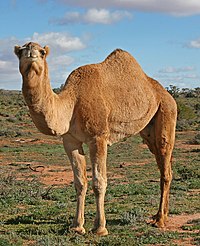
Photo from wikipedia
At the onset of lactation, calcium (Ca) homeostasis is challenged. For the transitioning dairy cow, inadequate responses to this challenge may result in subclinical hypocalcemia (SCH) at some point in… Click to show full abstract
At the onset of lactation, calcium (Ca) homeostasis is challenged. For the transitioning dairy cow, inadequate responses to this challenge may result in subclinical hypocalcemia (SCH) at some point in the postpartum period. It has been proposed that dynamics of blood Ca and the timing of SCH allows cows to be classified into 4 Ca dynamic groups by assessing serum total Ca concentrations (tCa) at 1 and 4 DIM. These differing dynamics are associated with different risks of adverse health events and suboptimal production. Our prospective cohort study aimed to characterize the temporal patterns of milk constituents in cows with differing Ca dynamics to investigate the potential of Fourier-transform infrared spectroscopic (FTIR) analysis of milk as a diagnostic tool for identifying cows with unfavorable Ca dynamics. We sampled the blood of 343 multiparous Holsteins on a single dairy in Cayuga County, New York, at 1 and 4 DIM and classified these cows into Ca dynamic groups using threshold concentrations of tCa (1 DIM: tCa <1.98 mmol/L; 4 DIM: tCa <2.22 mmol/L) derived from receiver operating characteristic curve analysis based on epidemiologically relevant health and production outcomes. We also collected proportional milk samples from each of these cows from 3 to 10 DIM for FTIR analysis of milk constituents. Through this analysis we estimated the milk constituent levels of anhydrous lactose (g/100 g milk and g/milking), true protein (g/100 g milk and g/milking), fat (g/100 g milk and g/milking), milk urea nitrogen (mg/100 g milk), fatty acid (FA) groups including de novo, mixed origin and preformed FA measured in g/100 g milk, by relative percentage (rel%), and g/milking, as well as energy related metabolites including ketone bodies and milk-predicted blood nonesterified FA. Individual milk constituents were compared among groups at each time point and over the entire sample period using linear regression models. Overall, we found differences among the constituent profiles of Ca dynamic groups at nearly every time point and over the entire sample period. The 2 at-risk groups of cows did not differ from each other at more than one time point for any constituent, however prominent differences existed between the milk of normocalcemic cows and the milk of the other Ca dynamic groups with respect to fatty acid groups. Over the entire sample period, lactose and protein yield (g/milking) were lower in the milk of at-risk cows than in the milk of the other Ca dynamic groups. In addition, milk yield per milking followed patterns consistent with previous Ca dynamic group research. Though our use of a single farm does limit the general applicability of these findings, our conclusions provide evidence that FTIR may be a useful method for discriminating between cows with different Ca dynamics at time points that may be relevant in the optimization of management or development of clinical intervention strategies.
Journal Title: Journal of dairy science
Year Published: 2023
Link to full text (if available)
Share on Social Media: Sign Up to like & get
recommendations!